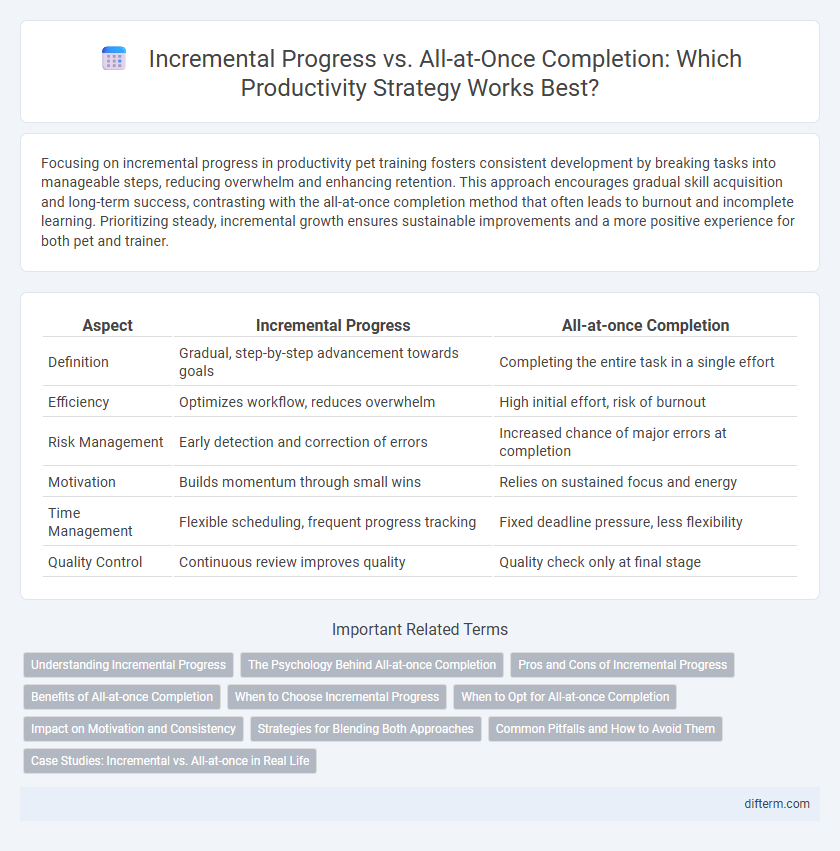Focusing on incremental progress in productivity pet training fosters consistent development by breaking tasks into manageable steps, reducing overwhelm and enhancing retention. This approach encourages gradual skill acquisition and long-term success, contrasting with the all-at-once completion method that often leads to burnout and incomplete learning. Prioritizing steady, incremental growth ensures sustainable improvements and a more positive experience for both pet and trainer.
Table of Comparison
| Aspect | Incremental Progress | All-at-once Completion |
|---|---|---|
| Definition | Gradual, step-by-step advancement towards goals | Completing the entire task in a single effort |
| Efficiency | Optimizes workflow, reduces overwhelm | High initial effort, risk of burnout |
| Risk Management | Early detection and correction of errors | Increased chance of major errors at completion |
| Motivation | Builds momentum through small wins | Relies on sustained focus and energy |
| Time Management | Flexible scheduling, frequent progress tracking | Fixed deadline pressure, less flexibility |
| Quality Control | Continuous review improves quality | Quality check only at final stage |
Understanding Incremental Progress
Incremental progress involves breaking tasks into smaller, manageable steps, enabling consistent achievements that build momentum over time. This approach reduces overwhelm and enhances motivation by providing clear milestones and measurable outcomes. Research shows that sustained incremental efforts improve productivity and lead to higher-quality results compared to attempting all-at-once completion.
The Psychology Behind All-at-once Completion
All-at-once completion leverages the psychological principle of instant gratification, triggering a dopamine release that enhances motivation and reinforces task engagement. This approach often creates a strong sense of accomplishment, boosting confidence and reducing procrastination. However, the pressure to finish everything simultaneously can increase stress and decrease overall productivity if not managed effectively.
Pros and Cons of Incremental Progress
Incremental progress fosters consistent momentum, allowing for regular assessment and adjustment that reduces the risk of major errors or rework. This approach enhances motivation by providing frequent accomplishments and manageable tasks, which can prevent burnout and overwhelm. However, it may extend the overall timeline and sometimes lead to fragmented focus, especially if priorities shift frequently or integration challenges arise.
Benefits of All-at-once Completion
All-at-once completion maximizes momentum by allowing tasks to be fully finished, leading to immediate results and a clear sense of achievement that boosts motivation. This approach reduces cognitive load by eliminating the need to constantly switch between unfinished tasks, enhancing focus and efficiency. Completing projects in one session also facilitates better resource management and quicker feedback, accelerating overall productivity and decision-making processes.
When to Choose Incremental Progress
Incremental progress enhances productivity by breaking complex tasks into manageable steps, which helps maintain motivation and reduces overwhelm. This approach is ideal when working on long-term projects, learning new skills, or when continuous feedback is necessary to adapt and improve. Choosing incremental progress supports steady momentum and prevents burnout, maximizing efficiency in dynamic and uncertain environments.
When to Opt for All-at-once Completion
Choose all-at-once completion when tasks require intense focus and have interdependent components that benefit from simultaneous execution. This approach suits scenarios with fixed deadlines where partial progress delivers little immediate value or where momentum hinges on finishing all parts together. High-complexity projects in product launches or event planning often gain efficiency by consolidating efforts into one coherent push.
Impact on Motivation and Consistency
Incremental progress sustains motivation by providing frequent achievements that reinforce a sense of advancement and capability, fostering long-term consistency in productivity habits. In contrast, all-at-once completion can create intense bursts of motivation but often leads to burnout and decreased momentum over time. Fostering regular, manageable milestones enhances psychological resilience and maintains steady engagement with tasks, positively impacting overall productivity.
Strategies for Blending Both Approaches
Combining incremental progress with all-at-once completion enhances productivity by allowing consistent momentum while meeting critical deadlines. Utilizing time-blocking techniques enables focused bursts of activity to tackle immediate tasks, followed by steady, smaller steps to sustain long-term goals. Integrating adaptive goal-setting tools helps balance urgency and persistence, optimizing efficiency across diverse project demands.
Common Pitfalls and How to Avoid Them
Incremental progress often leads to consistent, sustainable productivity by breaking tasks into manageable steps and avoiding burnout. Common pitfalls include underestimating time requirements and losing motivation due to slow visible progress, which can be mitigated through setting clear milestones and tracking small achievements. Conversely, attempting all-at-once completion risks overwhelm and errors, best avoided by prioritizing tasks and scheduling regular review checkpoints.
Case Studies: Incremental vs. All-at-once in Real Life
Case studies comparing incremental progress and all-at-once completion reveal that incremental approaches often lead to higher quality outcomes and sustained motivation by breaking tasks into manageable steps. For example, software development projects using Agile methods demonstrate improved adaptability and reduced risk compared to traditional waterfall models that aim for completion in a single phase. In contrast, all-at-once strategies may deliver faster results initially but can suffer from higher error rates and increased stress, impacting long-term productivity.
Incremental Progress vs All-at-once Completion Infographic

 difterm.com
difterm.com